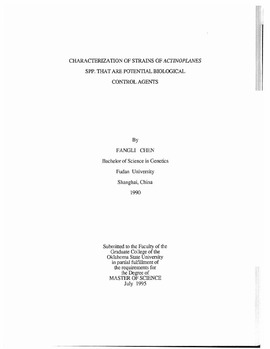| dc.description.abstract | Actinoplanes spp. are members of the aggregate group actinoplanetes in the family Micromonosporaceae of the order Actinomycetales. Actinoplanes spp. produce well-developed, nonfragmenting, branched and septate hyphae that are 0.2-1.6 ~ in diameter (Couch, 1974; Vobis, 1989). Aerial mycelium is generally not formed. The mycelium is typically Gram-positive, non-acidfast and produces diffusable pigments of many colors. Colonies are generally brightly colored. Various shades of orange are most frequent, although some strains have black, brown, red, purple, green or blue colored mycelia. Actinoplanes spp. typically produce spherical to subspherical shaped sporangia (3-20 x 630 j..lm) borne on sporangiophores (Goodfellow and Cross, 1984; Palleroni, 1989). Spherical, subspherical or rod-shaped spores are formed inside sporangia and become motile when hydrated. Zoospores (motile spores) have a few to many polar flagella (Vobis, 1989). Other genera of the actinoplanetes include Ampullariella, Pilimelia, and Dactylosporangium (Goodfellow et at.., 1990). Species of the actinoplanetes are economically important for their abilities to produce antibiotics, enzymes, immuno-suppressive drugs, steroids, and other industrial and pharmaceutical compounds (Goodfellow et al., 1984; Piret, 1988). Other members of Actinomycetales, e.g. Streptomyces spp. have provided greater commercial benefit and have been studied to a greater extent than the actinoplanetes. However, Actinoplanes spp. have been reported to be hyperp,arasitic of oospores of Phytophthora megasperma glycinea (Filonow and Lockwood. 1985) and similar fungi (Sneh et al., 1977; Sutherland and Lockwood, 1984; Khan et al., 1993). Identification of microbial species is based on their morphology, physiology, biochemical and nucleic acid composition. Studies of the latter two characteristics have evolved into the fields of chemical and genetic taxonomy. Chemical taxonomy typically involves the determination of biochemical constituents of the cell such as fatty acids profiles, or amino acids in ceil walls and sugars in whole cell hydrolysates (GoodfeUow and Cross, 1984; Lechevalier, 1970 and Pulleroni, 1989). Chemical taxonomy often leads to a reclassification of genus and species. Recently, Goodfellow et al. (1990) used chemical and numerical taxonomic procedures to clarify the taxonomy of Actinoplanes and related taxa. Based on their study, five novel species of Actinoplanes were identified and the genus Ampullariella was suggested to be a synonym of Aetinoplanes based on their chemical relatedness. The characterization of nucleic acid bas greatly improved taxonomic study of bacteria and other microbes, especially in non-fI.1amentaneous bacteria. Numerous techniques are available for the characterization of chromosomal or plasmid DNA and of ribosomalRNA (Farina and Bradley, 1970; Hopwood et al., 1983 and Wilson et al., 1990). The use of restriction endonuclease digestion of genomic DNA followed by band separation by agarose or SDS-PAGE gel electrophoresis (DNA fingerprinting) has evolved into a powerful yet relatively simple tool for characterizing bacterial strains and other microorganisms (Owen, 1989). DNA fingerprinting has been used for characterizing strains of Streptomyces (Crameri et al., 1983; Hintermann, 1981), Nocardia (Crameri et al., 1983) and Streptococcus (Skjold et al., 1987). Moreover, DNA fingerprinting has been applied for identification of closely related species in the genera Bacteroids, Brucella, Mycobacterium, and Lactobacillus (Stahl et al., 1990). Thus, DNA finger-printing is a useful tool for taxonomy. However, there is. no report of DNA fingerprinting of any member of the Actinoplanaceae, although DNA base composition (Palleroni, 1989) and DNA-DNA reassociation (Farina and Bradley, 1970) studies have been done. Moreover, p[asmids. have been identified in Streptomyces spp. and other actinomycetes (Hopwood and Brodsky, 1986; Hutter and Eckhandt, 1988; Kieser, 1984), yet little is known about the occurrence of plasmids in Actinoplanes spp. or the role they may play in the life cycle of Actinoplanes. Development of nucleic acid methods for the characterization of Actinoplanes spp. is needed to fill this void of knowledge. The objectives of my research are: (1) to detennine the frequency of occurrence of plasmids in several strains of known and unknown species of Actinoplanes that are potential biological agents; (2) to develop a protocol for the DNA figerprinting of genomic DNA from these species and strains; and (3) to compare DNA figerprinting to the analysis of cell wall amino acids and whole cell sugars as methods for the characterization of strains. | |
